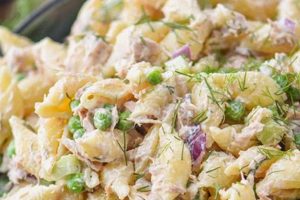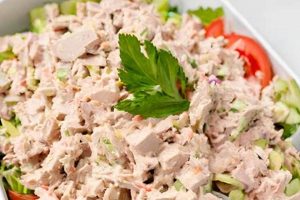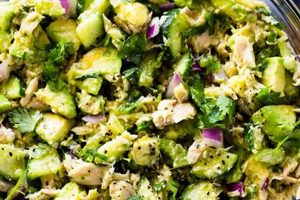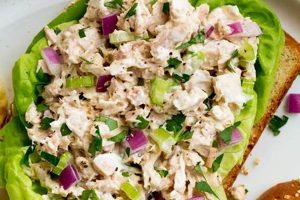Combinations of canned tuna, mayonnaise, and various other ingredients create a versatile dish suitable for sandwiches, salads, or crackers. A classic example includes celery, onion, and seasonings like salt and pepper, but variations can incorporate ingredients such as hard-boiled eggs, relish, grapes, or different herbs and spices.
This quick and easy meal offers a good source of protein and healthy fats, particularly when made with lean tuna and mindful additions. Its adaptability allows for creative customization to fit dietary needs and preferences, ranging from low-carb options using lettuce wraps to more indulgent versions with creamy dressings. Historically, canned tuna’s emergence in the early 20th century made such dishes increasingly accessible and affordable, contributing to their widespread popularity.
The following sections will delve deeper into specific variations, providing detailed instructions and nutritional information for a range of flavor profiles and dietary considerations.
Tips for Exceptional Tuna Salad
Creating flavorful and satisfying tuna salad involves attention to detail and a few key techniques. These tips offer guidance for elevating this simple dish.
Tip 1: Quality Ingredients Make a Difference: Opt for high-quality canned tuna packed in water or olive oil, avoiding overly processed varieties. Fresh, crisp vegetables and flavorful herbs contribute significantly to the overall taste.
Tip 2: Drain Thoroughly: Excess liquid from the canned tuna can dilute the flavor and create a watery consistency. Thorough draining ensures optimal texture and taste.
Tip 3: Mindful Mayonnaise Usage: Start with a smaller amount of mayonnaise and add more gradually to achieve the desired creaminess. This prevents an overly rich or heavy salad.
Tip 4: Seasoning Beyond Salt and Pepper: Explore diverse flavor profiles by incorporating seasonings such as Dijon mustard, lemon juice, garlic powder, or paprika. Freshly chopped herbs like dill or parsley add brightness.
Tip 5: Texture Variation: Introduce textural contrast with chopped celery, red onion, or water chestnuts. Consider adding chopped hard-boiled eggs or nuts for added protein and crunch.
Tip 6: Chill Before Serving: Chilling the prepared salad allows the flavors to meld and enhances the overall experience. This also improves the texture and consistency.
Tip 7: Creative Serving Options: Expand beyond traditional sandwiches and explore serving options such as lettuce wraps, stuffed tomatoes, or crackers for a lighter approach.
By employing these tips, one can consistently achieve delicious and satisfying tuna salad suitable for various occasions.
These insights provide a foundation for crafting the perfect tuna salad. The concluding section will offer additional resources and recipe variations.
1. Classic Tuna Salad
“Classic Tuna Salad” represents a foundational recipe within the broader category of “tuna fish salad recipes.” It serves as a starting point for numerous variations and embodies the core elements that define this versatile dish. Understanding its components provides a framework for exploring more complex and creative iterations.
- Core Ingredients:
The classic version typically includes canned tuna, mayonnaise, celery, and onion. These ingredients establish a familiar flavor profile and texture. Canned tuna provides the protein base, mayonnaise contributes creaminess, and celery and onion offer a satisfying crunch and subtle sharpness. This combination forms the basis upon which other ingredients can be layered.
- Seasoning:
Salt and pepper are the most common seasonings, enhancing the inherent flavors of the core ingredients without overpowering the palate. Simple seasoning allows the natural taste of the tuna and vegetables to shine through. This restraint also creates a versatile base that readily accommodates additional flavors.
- Preparation Method:
Classic tuna salad involves minimal preparation. Draining the tuna, chopping the vegetables, and combining all ingredients with mayonnaise constitutes the standard procedure. This straightforward method contributes to the dish’s enduring popularity as a quick and easy meal option.
- Serving Style:
While adaptable to various presentations, classic tuna salad is frequently served on bread as a sandwich or enjoyed with crackers. This traditional serving style reinforces its place as a convenient and familiar meal choice, suitable for casual dining and packed lunches.
By understanding the essential elements of classic tuna saladits core ingredients, simple seasoning, straightforward preparation, and traditional serving styleone gains a deeper appreciation for its role within the broader spectrum of tuna fish salad recipes. This fundamental understanding allows for informed experimentation and customization, leading to the creation of diverse and flavorful variations.
2. Mediterranean Tuna Salad
“Mediterranean Tuna Salad” represents a distinctive variation within the broader category of “tuna fish salad recipes.” It incorporates characteristic flavors and ingredients inspired by Mediterranean cuisine, offering a refreshing and flavorful alternative to traditional preparations. This exploration delves into the key facets that distinguish this specific type of tuna salad.
- Key Ingredients:
Mediterranean tuna salad distinguishes itself through the inclusion of ingredients such as Kalamata olives, feta cheese, capers, and red onion. These ingredients contribute a briny, salty, and tangy flavor profile characteristic of Mediterranean cuisine. The olives and capers provide a salty, briny burst, while feta cheese adds a creamy, tangy element. Red onion contributes a pungent bite, complementing the other flavors.
- Flavor Profile:
The emphasis on fresh herbs and a light, vibrant dressing further sets Mediterranean tuna salad apart. Herbs like dill, oregano, and mint are frequently incorporated, adding an aromatic complexity. Lemon juice or a light vinaigrette replaces the heavier mayonnaise-based dressings common in other tuna salads, creating a brighter, more refreshing taste. This emphasis on fresh, vibrant flavors aligns with the principles of Mediterranean cuisine.
- Health Benefits:
The use of olive oil and an abundance of fresh vegetables contributes to the perceived health benefits of this variation. Olive oil provides healthy fats, while the vegetables offer essential vitamins and minerals. Compared to mayonnaise-heavy versions, Mediterranean tuna salad often presents a lighter, more nutrient-rich option. This focus on healthful ingredients aligns with the broader health-conscious trends associated with Mediterranean diets.
- Serving Suggestions:
Mediterranean tuna salad lends itself well to various serving styles beyond traditional sandwiches. It can be served as a salad on a bed of greens, stuffed into pita bread, or used as a filling for bell peppers or tomatoes. These versatile serving options further enhance its appeal, catering to diverse preferences and dietary needs.
By incorporating characteristic Mediterranean ingredients and flavors, this variation offers a unique and flavorful experience within the broader context of “tuna fish salad recipes.” Its emphasis on fresh ingredients, vibrant flavors, and lighter preparations provides a compelling alternative to more traditional mayonnaise-based tuna salads, further demonstrating the versatility and adaptability of this popular dish.
3. Spicy Tuna Salad
Spicy Tuna Salad stands as a distinct category within the broader spectrum of “tuna fish salad recipes.” This variation introduces heat and complexity, appealing to those who prefer bolder flavors. The connection lies in the foundational elements of tuna saladcanned tuna, a binding agent (typically mayonnaise), and seasoningsupon which the spicy element builds. The cause-and-effect relationship is simple: the addition of spices or spicy ingredients directly results in a spicier flavor profile. The importance of this category lies in its expansion of flavor possibilities, catering to a wider range of palates. For example, incorporating diced jalapeos or a dash of hot sauce transforms the traditional flavor profile, creating a new culinary experience rooted in the basic tuna salad concept. Another example includes using chipotle mayonnaise or adding a pinch of cayenne pepper, demonstrating the versatility of achieving spice within this dish.
The practical significance of understanding this connection lies in the ability to customize spice levels and flavor profiles. One can achieve mild heat with a sprinkle of black pepper or create a fiery kick with chopped habaneros or sriracha. Furthermore, exploring different types of peppers, spices, or spicy sauces allows for nuanced flavor variations, moving beyond simple heat to incorporate smokiness, sweetness, or tanginess. For instance, a spicy tuna salad featuring sriracha mayonnaise and chopped cilantro offers a different experience from one made with jalapeos and cumin. This understanding empowers individuals to tailor recipes precisely to their spice preferences and explore a broader range of flavor combinations within the “tuna fish salad recipes” landscape.
Spicy tuna salad occupies a significant niche within the broader context of “tuna fish salad recipes.” It exemplifies the adaptability of this simple dish, demonstrating how the foundational elements can serve as a canvas for diverse flavor profiles. Understanding the relationship between the basic components and the spicy additions enables customization and exploration, leading to a richer culinary experience. While challenges may include balancing heat with other flavors and catering to varying spice tolerances, the versatility of spicy tuna salad ensures its continued popularity and relevance within the realm of tuna-based cuisine.
4. Tuna Salad Sandwiches
“Tuna Salad Sandwiches” represent a prominent application of “tuna fish salad recipes,” showcasing the versatility and convenience of this popular dish. This exploration examines the multifaceted relationship between the two, highlighting the sandwich’s role as a primary vehicle for tuna salad consumption.
- The Tuna Salad Filling:
The core of any tuna salad sandwich lies in the tuna salad itself. “Tuna fish salad recipes” provide the foundation, dictating the flavor profile and texture of the filling. Whether a classic preparation, a spicy variation, or a health-conscious rendition, the chosen recipe directly impacts the overall sandwich experience. A classic tuna salad with mayonnaise, celery, and onion creates a familiar taste, while a curried tuna salad offers a more exotic flavor profile. The recipe’s influence on the final product underscores the essential connection between “tuna fish salad recipes” and the resulting sandwich.
- Bread Selection:
The choice of bread significantly influences the sandwich’s character. From classic white bread to whole wheat, rye, or sourdough, the bread’s texture and flavor interact with the tuna salad, creating a composite sensory experience. A croissant offers a buttery, flaky counterpoint to the creamy tuna salad, while a hearty multigrain bread provides a robust, textural contrast. This interplay highlights the importance of bread selection in maximizing the enjoyment of tuna salad within a sandwich format.
- Complementary Ingredients:
Beyond the core components, additional ingredients can enhance the tuna salad sandwich. Lettuce, tomato, onion, and pickles are common additions, providing textural and flavor contrasts. Cheese, such as cheddar or Swiss, can add another layer of richness and complexity. The inclusion of these elements further demonstrates how “tuna fish salad recipes” serve as a starting point for customized culinary creations within the sandwich format.
- Serving Styles and Occasions:
Tuna salad sandwiches adapt to various contexts. They serve as convenient lunchbox staples, quick weeknight meals, or picnic fare. Whether served simply or presented with sides, the adaptability of the tuna salad sandwich underscores its practicality and broad appeal. This versatility further solidifies the connection between “tuna fish salad recipes” and their practical application in everyday meal scenarios.
Tuna salad sandwiches exemplify the practical application of “tuna fish salad recipes,” transforming a versatile mixture into a convenient and widely enjoyed meal. The choice of recipe, bread, and complementary ingredients allows for extensive customization, demonstrating the dynamic interplay between recipe and final product. This exploration underscores the tuna salad sandwich’s significance as a culinary canvas, showcasing the adaptability and enduring appeal of tuna salad in a readily consumable format.
5. Tuna Salad Lettuce Wraps
“Tuna Salad Lettuce Wraps” represent a contemporary and health-conscious adaptation of traditional “tuna fish salad recipes.” This preparation replaces bread or crackers with crisp lettuce leaves, offering a lighter, lower-carbohydrate alternative. The connection lies in the utilization of tuna salad as the central component, demonstrating the versatility of “tuna fish salad recipes” in adapting to evolving dietary preferences and culinary trends.
- Health and Dietary Considerations:
Lettuce wraps cater to low-carb, gluten-free, and health-conscious diets. Replacing bread with lettuce significantly reduces carbohydrate and calorie intake while increasing vegetable consumption. This adaptation aligns with current dietary trends that prioritize whole foods and minimize processed ingredients. The implications for “tuna fish salad recipes” are significant, demonstrating their adaptability to meet diverse dietary needs without sacrificing flavor or satisfaction.
- Flavor and Texture Dynamics:
The crisp, refreshing texture of lettuce complements the creamy tuna salad filling, creating a contrasting textural experience. The lettuce’s subtle flavor allows the nuances of the tuna salad to shine through, while also providing a refreshing counterpoint to richer variations. Examples include using butter lettuce for its delicate flavor or romaine lettuce for its sturdiness. This interplay of textures and flavors enhances the overall enjoyment of the dish, showcasing how “tuna fish salad recipes” can be elevated through thoughtful ingredient pairings.
- Presentation and Versatility:
Lettuce wraps offer an aesthetically pleasing and versatile presentation. They can be served as appetizers, light lunches, or components of larger meals. The individual portions allow for easy customization and portion control, making them suitable for various occasions. From casual gatherings to more formal settings, lettuce wraps provide an elegant and convenient serving option, expanding the application of “tuna fish salad recipes” beyond traditional sandwiches.
- Customization and Recipe Adaptation:
The lettuce wrap format encourages creativity with “tuna fish salad recipes.” Adapting recipes to complement the lettuce’s flavor and texture becomes a key consideration. For instance, a spicy tuna salad with Asian-inspired flavors pairs well with crisp iceberg lettuce, while a Mediterranean tuna salad complements butter lettuce. This flexibility further demonstrates the adaptability of “tuna fish salad recipes,” encouraging culinary experimentation and personalized flavor combinations.
Tuna salad lettuce wraps signify an evolution in the utilization of “tuna fish salad recipes,” reflecting a growing awareness of dietary preferences and a desire for lighter, more healthful meal options. By substituting traditional bread with lettuce, this preparation expands the culinary possibilities of tuna salad while highlighting its inherent versatility. The interplay of flavors, textures, and presentation underscores the lettuce wrap’s role as a contemporary and adaptable vehicle for enjoying a classic dish in a fresh, health-conscious manner. This adaptation ultimately broadens the appeal and relevance of “tuna fish salad recipes” in the modern culinary landscape.
6. Healthy Tuna Salad Options
“Healthy Tuna Salad Options” represent a significant subcategory within the broader context of “tuna fish salad recipes.” This focus on health-conscious preparations reflects evolving dietary trends and a growing awareness of nutritional considerations. The connection lies in the adaptation of traditional recipes to prioritize nutritional value without sacrificing flavor or satisfaction. Cause and effect are evident: modifications to ingredients and preparation methods directly impact the nutritional profile of the resulting tuna salad. For example, substituting Greek yogurt for mayonnaise reduces fat content while increasing protein, demonstrating a direct cause-and-effect relationship between ingredient choices and nutritional outcomes. Similarly, incorporating more vegetables, such as chopped bell peppers or cucumbers, increases fiber and vitamin intake, further illustrating the link between recipe modifications and health benefits.
The importance of “Healthy Tuna Salad Options” as a component of “tuna fish salad recipes” lies in its ability to broaden the appeal of this classic dish to health-conscious individuals. By offering variations that align with dietary restrictions and nutritional goals, this category ensures the continued relevance and adaptability of tuna salad in the modern culinary landscape. Practical examples abound: using tuna packed in water instead of oil reduces fat and calories; opting for whole-wheat bread or lettuce wraps instead of white bread lowers carbohydrate intake and increases fiber; adding chopped vegetables boosts vitamin and mineral content. These practical applications demonstrate how simple modifications can yield significant nutritional improvements, making tuna salad a viable option for a wider range of dietary needs.
“Healthy Tuna Salad Options” represent a vital and evolving aspect of “tuna fish salad recipes.” This category reflects a broader shift towards health-conscious eating habits, demonstrating the adaptability of classic dishes to meet contemporary dietary needs. While challenges may include balancing flavor with nutritional goals and navigating ingredient substitutions, the continued development of “Healthy Tuna Salad Options” ensures the enduring popularity and versatility of tuna salad as a nutritious and satisfying meal choice. This focus on health not only expands the culinary possibilities of tuna salad but also contributes to a more holistic and health-aware approach to food preparation and consumption.
Frequently Asked Questions
This section addresses common inquiries regarding the preparation, storage, and variations of tuna salad.
Question 1: What is the best type of tuna to use for tuna salad?
Canned tuna packed in water is generally recommended for its lower fat content. Tuna packed in olive oil can be used for a richer flavor, but contributes additional fat and calories. Solid or chunk light tuna offer firmer texture, while flaked tuna results in a finer consistency.
Question 2: How long can tuna salad be stored in the refrigerator?
Tuna salad should be stored in an airtight container in the refrigerator for no more than 3-5 days. Proper refrigeration helps maintain its quality and prevents bacterial growth.
Question 3: Can tuna salad be frozen?
Freezing tuna salad is not generally recommended. Freezing can negatively affect the texture and consistency of the mayonnaise, resulting in a watery or separated mixture upon thawing.
Question 4: How can one reduce the sodium content in tuna salad?
Rinsing canned tuna under cold water can help reduce sodium content. Using low-sodium mayonnaise and minimizing added salt in the recipe further contributes to a lower-sodium dish.
Question 5: What are some healthy alternatives to mayonnaise in tuna salad?
Greek yogurt, mashed avocado, or hummus can serve as healthier alternatives to mayonnaise, providing creaminess while reducing fat and calorie content. These substitutions also offer unique flavor profiles.
Question 6: How can tuna salad be made more flavorful?
Fresh herbs, spices, and other flavorful additions can enhance the taste of tuna salad. Consider incorporating ingredients such as diced red onion, chopped celery, Dijon mustard, lemon juice, or black pepper to create a more complex and satisfying flavor profile. Experimentation with different herbs and spices can lead to personalized flavor combinations.
Understanding these common inquiries provides a foundation for successful tuna salad preparation and enjoyment.
The following section offers a collection of curated “tuna fish salad recipes” for further exploration.
Tuna Fish Salad Recipes
This exploration of tuna fish salad recipes has traversed the spectrum from classic preparations to innovative variations. Key components, including core ingredients, flavor profiles, and dietary adaptations, have been examined. The versatility of this dish, adaptable to diverse palates and nutritional needs, has been clearly demonstrated. From simple adjustments like incorporating different herbs and spices to more substantial modifications like substituting Greek yogurt for mayonnaise, the potential for customization within the realm of tuna fish salad recipes is vast.
Tuna fish salad recipes represent more than just a convenient meal option; they offer a canvas for culinary creativity and a testament to the enduring appeal of simple, adaptable ingredients. Continued exploration and experimentation within this culinary domain promise further innovation and personalized enjoyment. The future of tuna fish salad recipes lies in the ongoing adaptation to evolving tastes and dietary preferences, ensuring its continued relevance as a culinary staple.






